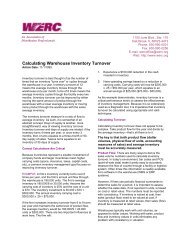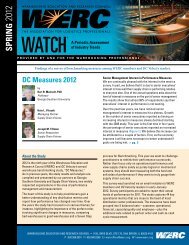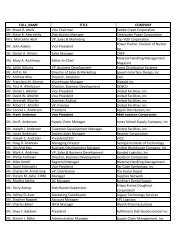Optimizing Inventory Management - WERC
Optimizing Inventory Management - WERC
Optimizing Inventory Management - WERC
You also want an ePaper? Increase the reach of your titles
YUMPU automatically turns print PDFs into web optimized ePapers that Google loves.
However, before inventory optimization can begin<br />
several essential steps must first be taken, advises<br />
Donovan. They include:<br />
Clearly define your customer service strategy and<br />
objectives.<br />
Develop a demand and supply plan to achieve your<br />
customer service strategy and objectives.<br />
Use the appropriate statistical forecasting algorithms<br />
to predict demand and its variability.<br />
“It usually advisable to start with simple optimization<br />
and then progress to more complex modeling over time,”<br />
he offers.<br />
Preparation<br />
Over the past decade, IO has become a mature discipline<br />
with a portfolio of best practices. “It is based on<br />
powerful, widely-applied formulae from the operations<br />
research branch of mathematics,” explains Bursa. “A<br />
best-of-breed multi-echelon inventory optimization<br />
solution addresses both strategic inventory policy planning<br />
and tactical inventory target setting in one<br />
solution.”<br />
Similar to most software initiatives, data is the key.<br />
“It’s essential that a company develop a demand and<br />
supply planning process,” emphasizes Donovan. “If reasonably<br />
good numbers are non-existent, then optimizing<br />
is all but impossible. When the process is well-defined,<br />
information technology system support is much easier<br />
to select and effectively use.”<br />
“Proper preparation relies on access to clean, accurate<br />
data,” Bursa agrees.<br />
<strong>Inventory</strong> planning and optimization in a singleechelon<br />
DC has the objective to deploy the right amount<br />
of inventory for each SKU to meet a management defined<br />
customer service strategy, says Donovan. In a multiechelon<br />
inventory network the IO objective is to<br />
simultaneously optimize customer service and inventory<br />
deployment strategies by taking into account inventory<br />
requirements in multiple locations throughout an entire<br />
supply chain network.<br />
“Multi-echelon inventory optimization (MEIO) incorporates<br />
multiple supply chain stages and helps bring the<br />
benefits to work-in-process as well as raw materials,” says<br />
Bursa. While MEIO is common at larger manufacturers in<br />
high tech, CPG, food and beverage, and life sciences,<br />
companies under $1-billion in revenue have begun to<br />
implement MEIO as well. “As the benefits are achieved in<br />
one stage, it is rolled out across the supply chain into<br />
other stages,” she explains.<br />
Education<br />
Donovan acknowledges that inventory optimization<br />
in a multi-echelon inventory network is a very complex<br />
task, and that software providers have sophisticated systems<br />
to support simultaneous inventory optimization in<br />
a supply chain. However, a common problem he’s<br />
observed is that users of these solutions have difficulty<br />
explaining what is “happening behind the screen” and<br />
when reviewing the outputs, few can identify whether<br />
the optimization process created an optimal solution.<br />
He therefore recommends that<br />
“knowledge and process should<br />
come first and then be supported<br />
with the right information technology.”<br />
He recommends management<br />
implement the sequential steps of:<br />
(1) gain knowledge; (2) develop and<br />
refine the process; and (3) deploy the<br />
appropriate inventory optimization<br />
technology.<br />
The growth in utilization of IO<br />
tools is all about education, Ellis<br />
maintains. “Although manufacturing companies have<br />
been increasingly focused on lowering inventory levels,<br />
there is still a fair degree of ‘education’ required for those<br />
companies to understand whether those lower inventory<br />
levels are productive or not,” he explains. “In and of itself, a<br />
low inventory level may not be a good thing, particularly if<br />
it gets in the way of customer service levels. As we have<br />
pointed out, all inventory levels are not created equally.<br />
At a particular level, a productive inventory can drive<br />
greater service performance,” Ellis shares.<br />
Benefits<br />
An advantage of IO is its “side-by-side” relationship<br />
to enterprise systems such as ERP and APS. As Bursa<br />
explains: The IO system is provided readily available data<br />
regarding existing business operations and monetized<br />
values for the supply chain components. Then, running<br />
independently of any enterprise systems, IO maps the<br />
supply chain interdependencies and produces an expert<br />
analysis of the causes of inventory throughout the<br />
supply chain.<br />
The IO tool then creates a series of “what-if” scenarios<br />
based on the organization’s improvement ideas and<br />
alternative configurations. The resulting inventory<br />
policies and targets can be implemented within the<br />
company’s existing business systems.<br />
Other benefits that have been reported from adopting<br />
inventory optimization tools and technology, which<br />
“<strong>Inventory</strong><br />
optimization tools …<br />
look at multiple<br />
kinds of inventory<br />
at multiple points in<br />
the supply chain …”<br />
Simon Ellis<br />
continued on page 8<br />
/ September–October 2010 3







